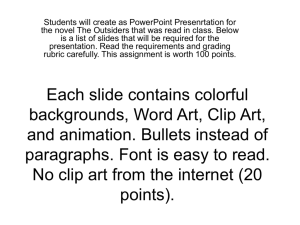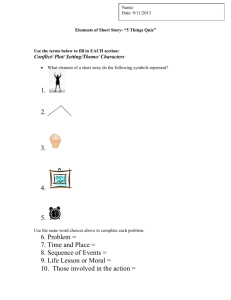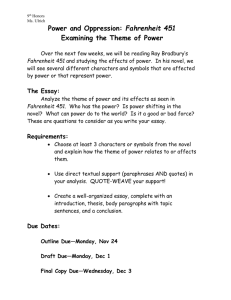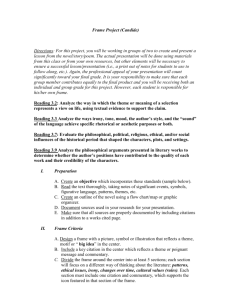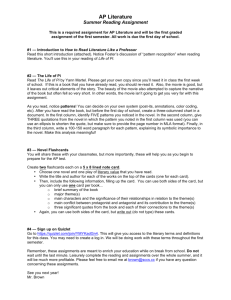Eng8Lit Wk6 Qt4 PPT
advertisement
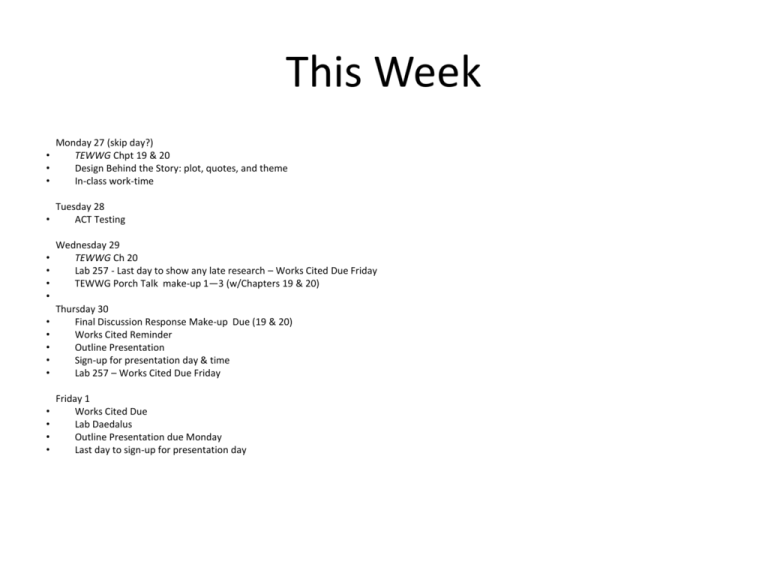
This Week • • • Monday 27 (skip day?) TEWWG Chpt 19 & 20 Design Behind the Story: plot, quotes, and theme In-class work-time • Tuesday 28 ACT Testing • • • • Wednesday 29 TEWWG Ch 20 Lab 257 - Last day to show any late research – Works Cited Due Friday TEWWG Porch Talk make-up 1—3 (w/Chapters 19 & 20) • • • • • Thursday 30 Final Discussion Response Make-up Due (19 & 20) Works Cited Reminder Outline Presentation Sign-up for presentation day & time Lab 257 – Works Cited Due Friday • • • • Friday 1 Works Cited Due Lab Daedalus Outline Presentation due Monday Last day to sign-up for presentation day Hook, Housekeeping & Homework Monday Have out your novel (fictional text) to read Quietly read for approx. 10 minutes. Returns Remember… • no electronics out/on during reading time • you are receiving credit for being on time, • ready to read with your choice, independent reading novel, • and actively reading during the given time. • If you do not have your book with you, must read something else. • If you finish reading a book, let me know. You’ll need to fill out a ½ sheet review and post it in the room! Homework: You should be done reading your novel by tomorrow (Tuesday)! Past, Present, Future Monday • Lab Daedalus • Show me last week’s research on your Historical Context Research • Last day to show any research is next Wednesday (see next slides) • Chapter 19 & Chapter 20 • Last day to make-up any Porch Talks (must do Chapters 19 & 20 Wednesday) – see next slide • Design Behind the Story & Theme (handouts) • ACT Testing – No School FYI • If you have missed any porch talk rotations, your last opportunity to make-up for partial credit is Wednesday in class with other students (absent or ones you’ve arranged to help you) • There are assignment sheets for chapters 19 & 20 for this make-up rotation. • See me by Monday! The Novel Monday Standards 2. Reading for All Purposes 4. Research and Reasoning Objective: you will be able to read and research a complex piece of fiction for understanding of plot, author background, writing style, and historical context. Key Concepts • Character (representation of persons in narrative) • Context (social, historical, cultural setting in which text is produced) • Point of View (particular perspective brought) • Setting (the time and place in which the book happens & mood, atmosphere thereof) • Style (characteristic way writer uses linguistic devices, literary devices, and features for particular purpose and effect) • Theme (the central idea(s) the creator explores through a text) Relevance Connections: Identities and Relationships (Who am I? Who are you? What does it mean to be human?) As readers, the characters, point of view, setting, style, and theme draw us to particular texts that can span both time and culture. The knowledge and experiences from which a writer draws enables us, as readers, to make connections among text, creator, and audience, and allow us to explore our unique identities. Inquiry Questions: • Who are the characters? What are the like? What is the setting? What is the main conflict? How is it resolved? • What is the style and structure of this text? What craft tools does the author employ? • What do you know about the author? How does the author’s life or experiences contribute to this text? • In what literary period was it written? How does this work reflect this literary period? • What do you know about the time period in which it was written? What does this text reveal about its historical or cultural context? • What does this work reveal about what it means to be a human being in this world? What are the big ideas of this work of literature? How are they expressed through characters, point of view setting, setting and style? • How can readers identify with this author or with this text? Is this work relevant today? How and why? Who should read this and why? Assessment Tasks for Verbal Visual Essay Monday 1. Read at least one complex work of fiction in its entirety 2. Research the author’s life/background and writing style and consider how this influences any aspects of the novel, including the theme (consider any literary reviews or criticisms, also) 3. Research the historical context of novel (time period it was written/published and/or setting of novel) and consider how this influences any aspects of the novel, including the theme 4. Identify and write a relevant statement of theme for the work; this should be a complete, meaningful sentence. 5. Identify the major plot elements that support this theme 6. Select and record 3 - 4 direct quotes (each 1-3 sentences in length) from the novel that explain and demonstrate your understanding of the plot and theme Activity Monday Purpose: to analyze the design behind your novel and how it supports a theme. Tasks: As I discuss each literary element and task, consider them in relationship to your choice novel • Research the author’s life/background and writing style and consider how this influences any aspects of the novel, including the theme (consider any literary reviews or criticisms, and the literary time period also) Outcome: Notes on graphic organizer that may be used for presentation Task 2 • A writer's style is what sets his or her writing apart and makes it unique. Style is the way writing is dressed up (or down) to fit the specific context, purpose, or audience. Word choice, sentence fluency, and the writer's voice — all contribute to the style of a piece of writing Ernest Hemingway minimalist straight forward little punctuation, etc. literally happening vs. how it's written fragments futility, pessimism, instability, collapse of morality, lost sense of self -with a futuristic Reflects nature of a post apocalyptic world where everyone left is an animal. No names, no grammar rules = reflection of story Nihilism, i.e the complete annihilation of society. the degeneration of his language alludes to the degeneration of society. language becomes obsolete in the novel, people forget colors, names of birds etc. Writer’s Style - Design Behind Story: Figurative Language • Writers use figurative language such as imagery, similes, and metaphors to help the reader visualize and experience events and emotions in a story. • Imagery—a word or phrase that refers to sensory experience (sight, sound, smell, touch, or taste)— helps create a physical experience for the reader and adds immediacy to literary language. • Some figurative language asks us to stretch our imaginations, finding the likeness in seemingly unrelated things. • • Simile is a comparison of two things that initially seem quite different but are shown to have significant resemblance. Similes employ connective words, usually “like,” “as,” “than,” or a verb such as “resembles.” A metaphor is a statement that one thing is something else that, in a literal sense, it is not. By asserting that a thing is something else, a metaphor creates a close association that underscores an important similarity between these two things. • In Their Eyes Were Watching God, Janie reads natural phenomena as indicators of her internal landscape. As a result, Hurston’s writing is thick with language that draws us beyond the literal descriptions of people, places, and events. Janie uses simile to describe her life “like a great tree in leaf with the things suffered, things enjoyed, things done and undone.” Does your author write using much imagery or figurative language? What are some examples? What is the purpose and effect of these detailed descriptions and comparisons? For example, with TEWWG, consider… • How are these descriptions used figuratively: the road, ships, trees, the sun, eyes, time, God, dreams, judgment, speech, silence, and mules? • What other specific types of figurative language, such as simile, metaphor, or personification, does Hurston use? Where and why? The clocks stopped at 1:17. A long shear of light and then a series of low concussions. He got up and went to the window. What was it? she said. He didn’t answer. He went into the bathroom and threw the lightswitch but the power was already gone. A dull rose glow in the windowglass. He dropped to one knee and raised the lever to stop the tub and then turned on both taps as far as they would go. She was standing in the doorway in her nightwear, clutching the jamb, cradling her belly in one hand. What is it? she said. What is happening? I don’t know. Why are you taking a bath? I’m not. The clocks stopped at 1:17. There was a long shear of light and then a series of low concussions. He got up and went to the window. “What was it?” she said. He didn’t answer. He went into the bathroom and threw the light switch, but the power was already gone. A dull rose glow appeared in the window glass. He dropped to one knee and raised the lever to stop the tub and then turned on both taps as far as they would go. She was standing in the doorway in her nightwear, clutching the jamb, cradling her belly in one hand. “What is it?” she said. “What is happening?” “I don’t know.” “Why are you taking a bath?” “I’m not.” Why do they have to do that? I dont know. Are they going to eat them? I dont know. They’re going to eat them, arent they? Yes. And we couldnt help them because then they’d eat us too. Yes. And that’s why we couldnt help them. Yes. Okay. Writer’s Style Design Behind Story: Symbolism • Symbols are persons, places, or things in a narrative that have significance beyond a literal understanding. • The craft of storytelling depends on symbols to present ideas and point toward new meanings. • Most frequently, a specific object will be used to refer to (or symbolize) a more abstract concept. • The repeated appearance of an object suggests a non-literal, or figurative, meaning attached to the object. • Symbols are often found in the book’s title, at the beginning and end of the story, within a profound action, or in the name or personality of a character. • The life of a novel is perpetuated by generations of readers interpreting and reinterpreting the main symbols (archetypes!). By identifying and understanding symbols, readers can reveal new interpretations of the novel. Are there any symbols (concrete object representing abstract ideas) in your novel? Consider your lists of various of archetypes (plot, situational, characters, objects, colors, etc.) that exist? For example, with TEWWG, consider… • Outline the literal elements of the pear tree, the street lamp, or the mule before they discuss possible symbolic meanings. • The Pear Tree • What was Carla Kaplan’s and Azar Nafisi’s interpretations of this symbol in the NEW Audio Study Guide? • Janie journeys through two unsatisfying marriages; notice when she does (or does not) remember the pear tree. For what is she searching? Does she find it or do you think she will find it? • The Street Lamp • What does the street lamp in Chapter 5 communicate about the ideals of the Eatonville townspeople? Does it exemplify a control over nature that empowers the community? Why does Mrs. Bogle sing “Jesus, the light of the world” when the lamp is lit? What does Joe mean when he says: “And when Ah touch de match tuh dat lamp–wick let de light penetrate inside of yuh, and let it shine, let it shine, let it shine”? • The Mule • In Chapter 6, Bonner’s yellow mule stimulates the Eatonville men to “mule–talk.” How does this deepen the meaning of the mule, both literally and symbolically? How does Hurston capture the musical, imaginative talk of the townspeople in this scene? the primary setting highlights theme of transcendent simplicity reflects McCarthy’s sparse writing style Activity Monday • Purpose: to analyze the design behind your novel and how it supports a theme. • Tasks: As I discuss each literary element and task, consider them in relationship to your choice novel 1. Identify and write a relevant statement of theme for the work; this should be a complete, meaningful sentence. 2. Identify the major plot elements that support this theme 3. Select and record 3 - 4 direct quotes (each 1-3 sentences in length) from the novel that explain and demonstrate your understanding of the plot and theme • Outcome: Notes on graphic organizer that may be used for presentation Writer’s Style - Design Behind Story: Characterization & Plot Development • Novels trace the development of characters who encounter a series of challenges. • Most characters contain a complex balance of virtues and vices. • Internal and external forces require characters to question themselves, overcome fears, or reconsider dreams. • The protagonist may undergo profound change. A close study of character development maps, in each character, the evolution of motivation, personality, and belief. • The tension between a character’s strengths and weaknesses keeps the reader guessing about what might happen next and the protagonist’s eventual success or failure. • Many readers consider Their Eyes Were Watching God a bildungsroman, or coming-of-age novel. As Janie’s external journey takes her through southern Florida and her three marriages, she finds her voice and learns to use it. For example, with TEWWG, consider… • Map Janie’s development from the young woman under the pear tree to her life as Mrs. Killicks, Mrs. Starks, and Mrs. Woods. How has she changed? How has she remained the same? Writer’s Style - Design Behind Story: Setting Monday • Time • Place • Early 1900s • West Florida – Eatonville & Everglades • Verbal/Visual ( model next slide) • Where does your novel take place? • When? “Nobody wants to be here and nobody wants to leave.” ― Cormac McCarthy, The Road Writer’s Style Design Behind Story: Point of View • The narrator tells the story with a specific perspective informed by his or her beliefs and experiences. Narrators can be major or minor characters, or exist outside the story altogether. The narrator weaves her or his point of view, including ignorance and bias, into telling the tale. • A first-person narrator participates in the events of the novel, using “I.” • A distanced narrator, often not a character, is removed from the action of the story and uses the third person (he, she, and they). • The distanced narrator may be omniscient, able to read the minds of all the characters, • or limited, describing only certain characters’ thoughts and feelings. • Ultimately, the type of narrator determines the point of view from which the story is told. Their Eyes Were Watching God opens with an unidentified third-person narrator who remains outside the story. This anonymous, omniscient narrator immediately creates interest by declaring: “So the beginning of this was a woman and she had come back from burying the dead.” The first page also contains one of several allusions to the book’s title: “the sudden dead, their eyes flung wide open in judgment”; however, the narration changes when Janie tells her story to her best friend, Pheoby Watson. From what point of view is your novel told? How does it effect the telling of the story and the ideas presented? For example, with TEWWG, consider… • How can an omniscient narrator tell the story at the same time that the novel’s heroine, Janie, also tells her story? Do these voices reflect different parts of Janie, or does the omniscient narrator reveal another force in Janie’s universe? • Janie is judged throughout the novel. In the first chapter, who judges her, and why? How does Janie respond? • Why does Janie choose to tell her story only to her best friend Pheoby? How does our audience (especially friends) affect what we reveal or conceal? Writer’s Style Design Behind Story: Characters • The central character in a work of literature is called the protagonist. • The protagonist usually initiates the main action of the story and often overcomes a flaw, such as weakness or ignorance, to achieve a new understanding by the work’s end. • A protagonist who acts with great honor or courage may be called a hero. • An antihero is a protagonist lacking these qualities. • Instead of being dignified, brave, idealistic, or purposeful, the antihero may be cowardly, self-interested, or weak. • The protagonist’s journey is enriched by encounters with characters who hold differing beliefs. • One such character type, a foil, has traits that contrast with the protagonist’s and highlight important features of the main character’s personality. • The most important foil, the antagonist, opposes the protagonist, barring or complicating his or her success. What are the character types in your novel? What importance do they play? For example, with TEWWG, consider… • How do Logan and Joe reveal different sides of Janie? What are their motivations? • To what extent does Janie acquire her own voice and the ability to shape her own life? How are the two attributes related? The cannibals The woman Man struck by lightening The bad man from the truck Roadagents, the guys Ely Thief The man, the woman, the little boy Writer’s Style - Design Behind Story: Conflict Monday • Struggle between opposing forces that is the basis of the story’s plot. • External – pits the character against nature, society, or another character • Internal – conflict between opposing forces within a character • Verbal/Visual ( model next slide) Man vs. man "You wanted to know what the bad guys looked like. Now you know. It may happen again. My job is to take care of you. I was appointed to do that by God. I will kill anyone who touches you. Do you understand? Yes. He sat there cowled in the blanket. After a while he looked up. Are we still the good guys? he said. Yes. We're still the good guys.“ (65) Man vs. self “Listen to me, he said, when your dreams are of some world that never was or some world that never will be, and you're happy again, then you'll have given up. Do you understand? And you can't give up, I won't let you.” ― Writer’s Style - Design Behind Story: Climax & Resolution Monday • Climax The turning point of the action in the plot of a play or story. The climax represents the point of greatest tension in the work. • Chapter 19 Janie confronts Teacake • Hurricane hits • Resolution The sorting out or unraveling of a plot at the end of a play, novel, or story. • Janie returns to tell her story • “Ah been a delegate to de big ‘ssociation of life.” (18) • “Love is lak de sea.” It’s uh movin’ thing, but still and all, it takes its shape from de shore it meets, and it’s different with every shore.” (284) • “Two things everybody’s got tuh do fuh theyselves. They got tuh go tuh God, and they got tuh find out about livin’ fuh theyselves.” (285) • “Here was peace… She called in her soul to come and see.” (286) • Verbal/Visual ( model next slide) “You have to carry the fire." I don't know how to." Yes, you do." Is the fire real? The fire?" Yes it is." Where is it? I don't know where it is." Yes you do. It's inside you. It always was there. I can see it.” (234) "He slept close to his father that night and held him but when he woke in the morning his father was cold and stuff. He sat there a long time weeping..." (236). Writer’s Style - Design Behind Story: Theme • Identify and write a relevant statement of theme for the work • Identify the major plot elements that support this theme • Select and record 3 - 4 direct quotes (each 1-3 sentences in length) from the novel that explain and demonstrate your understanding of the plot and theme • • • • • What is this novel saying about…? Love, relationships Race Life experiences ??? Characteristics of a Theme Statement Characteristics of a Good Theme Statement • In a sense, every literary work makes a statement or has a point. • must be general enough to capture the overall meaning of the work • but specific enough so that it conveys your unique interpretation. • The theme statement should be a complete sentence. • "Love and death" (for example) is not a theme statement. It's just an announcement of the topic of the work. What in particular is the author saying about love and death? • A sentence like "The theme of the poem is love and death" is grammatically speaking a complete sentence, but if you remove the beginning of the sentence ("The theme of the poem is"), then you don't have a complete sentence, just a wordy announcement of the topic. • The theme statement should describe the general meaning of the work, not the specific events, actions, or characters. • The statement "Luke defeats Darth Vader" is not a theme statement but a plot summary. Instead of describing what the characters do, discuss what they represent ("Good defeats evil"). • Often the theme statement takes the form of a moral or a judgement ("We cannot defeat an external evil until we acknowledge our own dark side"). Of course this overall theme results from what the characters do (or from the literal meaning of words in a poem), and in supporting your general interpretation, you should cite some of these specific details. • The theme statement should reflect the values of the entire work, not just one or two episodes or lines. In particular, look at the end of the work to make sure that the story's outcome matches what you think its general meaning is. Pop quiz: Which of the following would be the best theme statement according to the above guidelines? 1. The true meaning of love. 2. Mrs. Farquar learns that British people can't dance. 3. Because the main character commits suicide, the theme is that we should all commit suicide. 4. It is better to have loved and lost than never to have lost at all. • Thanks: http://facstaff.gpc.edu/~shale/humanities/composition/handouts/theme.html Cormac McCarthy’s novel The Road speak to us about our human nature--the fire of human compassion can be all too easily extinguished when we encounter adversity. Tuesday ACT Testing LIBRARY • HAVE OUT THEIR EYES WERE WATCHING GOD - WE ARE RETURNING IT IN JUST A MOMENT! Hook, Housekeeping & Homework Wednesday Take a “Design Behind the Story” handout off the front table & read through it. What does your novel say about Past, Present, Future Wednesday • Senior skip day • See Monday’s slides (senior skip day) • If time - Lab 257 • Last day to show any late research – Works Cited Due Friday • Last day for any make-up TEWWG Porch Talks (w/Chapters 19 & 20) • • • • • Final Discussion Response Make-up Due (19 & 20) Works Cited Reminder Outline Presentation Sign-up for presentation day & time Lab 257 – Works Cited Due Friday If you have not already… • Quickly head over to the library and return Their Eyes Were Watching God! • I will start class a few minutes into the period if needed Hook, Housekeeping & Homework Thursday Works Cited Reminder: Final, printed copy due Friday I must have this in order for you to present. Questions? Past, Present, Future Thursday Plot, theme, etc. (handout) • Last day to show any late research – Works Cited Due Friday • Last day for any make-up TEWWG Porch Talks (w/Chapters 19 & 20) • Lab 257 – Works Cited Due Friday 1. 2. 3. 4. • • • • Works Cited Reminder Outline Presentation (handout) Sign-up for presentation day & time Final Discussion Response Make-up Due (19 & 20) Works Cited Due Lab Daedalus Outline Presentation due Monday Last day to sign-up for presentation day Tasks 7. Create a formal MLA Works Cited page: minimum 3 sources about your author, novel (e.g. literary review or criticism), and/or historical context; don’t forget to cite you novel as a source, too! Due Friday, May 1st 8. Find, create, and combine relevant images to complement and enhance the quotes 9. Produce a final Verbal Visual Essay that enhances the audiences’ understanding of the novel (its theme) and author (see Outcome). The visuals may be two-dimensional, threedimensional or a multimedia format. 10. Practice your 8 minute presentation 11. Sign up for a presentation day time slot Activities: Develop & Apply Thursday Purpose: to formally document the sources you will use in your presentation, to organize (outline) your ideas, to sign up for a day* Tasks: Lab 257 1. Create your final Works Cited page (word document), print and turn in by tomorrow • https://owl.english.purdue.edu/owl/resource/747/05/ 2. Outline Presentation • See handout for ideas 3. Sign-up for presentation day & time* (see next slides) • First come, first served Outcome: Final Works Cited page ready to turn in tomorrow, rough outline of presentation, presentation day recorded* *If you… …are the last presentation of the day, and time runs out, you will be first on the next day. …miss your day, you will be moved to another time slot (this may be the very last day) or have to come in on your own time. …are first the next day, and there is additional time the day before, you may volunteer to go early. Presentation Sign-up Period 1 10 minute time slots begin 1 minutes into period Mon May 4 Tues May 5 Weds May 6 Thurs May 7 1. Zacc J 1. Madelien H 1. Tim M 1. Noah G 2. Austin A 2. Gilbert F 2. Bobby G 3. Dylan R 3. Sam S 4. Alex S Not available Mon May 11 Tues May 12 X 1. Rachael W 1. Julia S 2. Cody L X 2. Tiffany K 2. Bayliegh D 3. Manny M 3. Jordan Y X 3. Aaron P 3. Tonas C-P 4. Marten R 4. Caesar A X 4. Ryan J 4. Kiel W X 5. Emani G 5. Travis H If you… …are the last presentation of the day, and time runs out, you will be first on the next day. …miss your day, you will be moved to another time slot (this may be the very last day) or have to come in on your own time. …are first the next day, and there is additional time the day before, you may volunteer to go early. Presentation Sign-up Period 6 10 minute time slots begin 1 minutes into period Tues May 5 Weds May 6 Thurs May 7 1. Aiden R 1. Eddie R 1. Conner 2. Megan T Not available Mon May 11 Tues May 12 X 1. Renae 1. LaNina 2.Alphonsine 2. Trevas X 2.Mariah 2. Joe C Aiden R 3. Jake W 3. Alyssa D 3. Anna X 3. Brycen 3. Donovan M 4. Jack F 4. Delphy 4. James H X 4. Vincent 4. Alisha H 5. Daniel X 5. Jonas A If you… …are the last presentation of the day, and time runs out, you will be first on the next day. …miss your day, you will be moved to another time slot (this may be the very last day) or have to come in on your own time. …are first the next day, and there is additional time the day before, you may volunteer to go early. Presentation Sign-up Period 7 10 minute time slots begin 1 minutes into period Tues May 5 Weds May 6 Thurs May 7 1. Joe A 1. Joey D 1. Robert S 2. Dylan S 2. Jacob T 3. Matt M 3. Ijah P 4. Lyzzi Not available Mon May 11 Tues May 12 X 1. Meghan 1. Tarik 2. Alena M X 2. Dominic 2. Chance 3. Christian X 3. Anwar B 3. Destiney 4. Gabe X 4. Orion 4. Sophia X If you… …are the last presentation of the day, and time runs out, you will be first on the next day. …miss your day, you will be moved to another time slot (this may be the very last day) or have to come in on your own time. …are first the next day, and there is additional time the day before, you may volunteer to go early. Hook, Housekeeping & Homework Friday Works Cited Reminder: Final, printed copy due TODAY! I must have this in order for you to present your final. Questions? Past, Present, Future Friday • Lab 257 – Works Cited Due Friday 1. 2. 3. 4. Works Cited Reminder Outline Presentation (handout) Sign-up for presentation day & time Final Discussion Response Make-up Due (19 & 20) • Lab Daedalus • Works Cited Due • Outline Presentation by Monday (handout from yesterday) • Today I will slot in people who did not sign up for presentation day and slot • Lab Daedalus • Outline Presentation due How is your presentation coming? Check List for your Verbal/Visual Essay Presentations Introduction: attention grabber, outline (thesis) of presentation Author, Title Brief outline of plot Statement of Theme (full sentence) 3-4 Quotes (cite the page number of the quotations) with Explanations 1) Beginning/Setting/Exposition; 2) Middle/Rising Action, Conflict and Climax; 3) End/Resolution Author Biography/Background Writing Style: structure, craft tools/literary devices You may include Literary Reviews or Criticisms Historical Context: Written/Published and/or Setting (literary period) Images to Represent Each Idea graphics that show the meaning of the quotes and contribute to theme Narration to Explain Each Idea Your work may also contain: animation or movement video sound or relevant music Conclusion: final thoughts (e.g. like/dislike, still/not relevant today, who would read it, theme) Activities: Develop & Apply Friday Purpose: to formally document the sources you will use in your presentation, to organize (outline) your ideas, to sign up for a day* Tasks: Lab 257 1. Create your final Works Cited page (word document), print and turn in • 2. Outline Presentation • 3. See handout for ideas Sign-up for presentation day & time* (see next slides) • 4. https://owl.english.purdue.edu/owl/resource/747/05/ First come, first served (lab) Create your presentation VISUALS = images; VERBAL = words out of your mouth; NOTECARDS to remember what to say to audience to make connections between/among your words (out of mouth & on screen) & your images Outcome: Final Works Cited page ready to turn in tomorrow, rough outline of presentation, presentation day recorded* *If you… …are the last presentation of the day, and time runs out, you will be first on the next day. …miss your day, you will be moved to another time slot (this may be the very last day) or have to come in on your own time. …are first the next day, and there is additional time the day before, you may volunteer to go early. Coming Soon! Are you ready for your Choice Novel Verbal/Visual Essay Presentation? Monday Presentation Sign-up Period 1 10 minute time slots begin 1 minutes into period Mon May 4 Tues May 5 Weds May 6 Thurs May 7 1. Zacc J 1. Madelien H 1. Tim M 1. Noah G 2. Austin A 2. Gilbert F 2. Bobby G 3. Dylan R 3. Sam S 4. Alex S Not available Mon May 11 Tues May 12 X 1. Rachael W 1. Julia S 2. Cody L X 2. Tiffany K 2. Bayliegh D 3. Manny M 3. Jordan Y X 3. Aaron P 3. Tonas C-P 4. Marten R 4. Caesar A X 4. Ryan J 4. Kiel W X 5. Emani G 5. Travis H If you… …are the last presentation of the day, and time runs out, you will be first on the next day. …miss your day, you will be moved to another time slot (this may be the very last day) or have to come in on your own time. …are first the next day, and there is additional time the day before, you may volunteer to go early. Period 1 Monday Purpose: to learn about our peer’s choice novels (and give them helpful feedback) Tasks: Listen attentively as the following peer’s present their choice novels 1. Zacc J 2. Austin A 3. Dylan R Outcome: Would you read one of these books? Which? Why or why not? What was done well for the presentation itself? Period 6 & 7 Monday Purpose: to finalize the visuals and organize (outline) & practice your presentation of your verbal visual essay. Tasks: 1. Did you turn in your Works Cited page? You can’t present without turning it in! 2. Do you know what day and slot you are presenting this week? (see other slides) 3. Outline Presentation • See handout for ideas 4. Create your presentation • VISUALS = images; VERBAL = words out of your mouth; NOTECARDS to remember what to say to audience to make connections between/among your words (out of mouth & on screen) & your images Outcome: Verbal/visual essay practiced or ready to practice *If you… …are the last presentation of the day, and time runs out, you will be first on the next day. …miss your day, you will be moved to another time slot (this may be the very last day) or have to come in on your own time. …are first the next day, and there is additional time the day before, you may volunteer to go early. How is your presentation coming? Self-Evaluation How much attention did I pay to…? o Understanding of theme in the novel? o Appropriate selection of quotes to show plot and theme? o Understanding of author? o Understanding of writing style? o Understanding of time period? o Appropriate selection of images? o Creativity? o Neatness & Correctness? o Source citations? o Confidence in my oral communication skills? o Judging the amount of time to spend on each idea to reach and not exceed the 8 minute time slot? How is your presentation coming? Grading Rubric (based on Colorado Academic Standards) 1. Oral Expression & Listening (15 pts.) 3. Writing & Composition (10 pts.) _____ Speaking skills _____ Correctness, neatness in presentation _____ Creativity, media, images _____ Citations (MLA Works Cited page, 3 _____ Time length (5 – 8 - 10) source minimum, mechanics/formatting) 2. Reading For All Purposes (30 pts.) 4. Research & Reasoning (20 pts.) _____ Author, title, plot _____ Author background _____ 3-4 quotes tied to theme _____ Structure, style, literary devices _____ Theme w/ explanation _____ Historical context (of setting and/or _____ Structure, style, literary devices publication, literary period)


